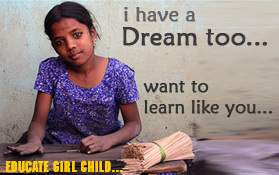We all need the realisation that goals need no spectacular efforts, just small consistent efforts built on a well advanced time frame. It goes back to the emphasis of an economy built on a well engaged society; with well-intended policies and a participatory society. Everyone has to find convergence within own creativity and effect positive change. Each one of us sense responsibility is in fact the little thing that brings big impact. In this context, my creativity is merely a dream that imagines women empowerment through girl child education. Having assumed the responsibilities of global citizenship, I want to put forward why girl child education is potentially among the best tools in achieving the MDGs, hence call for collective pursuit.
On a much basic level the value of education starts from embracing our African roots and getting connected to the sense of responsibility towards our communities. Operating from this platform, it becomes an affordable comfort to embed in the international agenda issues such as the MDGs.
Goal 1: Eradicate extreme poverty and hunger
Basic girl child education can be very imperative in assisting women acquire gainful employment through access to opportunities of global commerce. Given that women form a key labour force of the informal sector, enriching girl child access to education implies that women can consider large enterprises and formal markets as other sources of economic empowerment. The informal sector is characterized by easy entry of new enterprises, reliance on indigenous resources, family ownership, small scale operations, unregulated and competitive markets, labor intensive and informal acquired skills of workers (Narayana et al., 2007:2). Access to education, will ensure that even women within the informal sector are rewarded efficiently now as competent entrepreneurs.
Goal 2: Achieve universal primary education
Women’s literacy has a positive effect on children school enrolment, attendance and completion, thus a positive impact on access to basic education. Education literature suggests increased likely hood of children being sent to school if mothers have been subjected to some level of academic learning.
Secondly, given their world population majority, enhancing girl child education translates into increased universal primary education. Universal primary education contributes to augmented procurement of knowledge, values and skills required for sound and sustainable development made through all education channels including mass media, traditional communication and social action.
A child who is denied the opportunity of elementary schooling is not only deprived as a youngster but also handicapped all through life; as a person unable to do certain basic things that rely on reading, writing and arithmetic (Dighe, 2008).
Not surprising, most instances of fruitful opportunities of globalization have traced back to the circuit of basic education on a broad core. Already in the mid nineteenth century the undertaking was observed with significant logic in Japan. The concentration on basic education for all, determined to a large extent, the nature and speed of Japan’s economic and social progress (Japan’s Official Development Assistance, 1996).
Goal 3:Promote gender equality and empower women
Women empowerment has positive spillover effects. Women are not just one group among the various disempowered subsets of the society (the poor, ethnic minorities and abused), they are cross cutting category of individuals that overlaps with all these other groups (Mc Neilly, 2005). The foremost matter connects to the point that lack of education in form of illiteracy and innumeracy are indices of insecurity. Inability to read, write, count or communicate is its self a deficit. The extremities of insecurity include assurance of dispossession, and the null event to avoid that fate (Korten, 1996).
Goal 4:Reduce child mortality
Variables linking to women’s organization affirm that women education plays a focal role in fostering social wellbeing, in this regard, child survival. There is confirmation that women’s education tend to reduce mortality rates. This effect exhibits through numerous conduits, most instantly through the value that mothers’ accord to the welfare of children. The State of the World Population (1990), reported that one percent increase in women’s literacy rate is thrice more effective in curbing infant mortality than a one percent increase in the number of medical doctors.
Goal 5: Improve maternal health
Studies in several emerging countries have highlighted that women’s education is influential on the intensity of knowledge and understanding of hygiene, child and mother nourishment (particularly during pre and antenatal periods), control and prevention of diseases (transmissible or chronic) thereby lessening child mortality ratio The absolute effects of women illiteracy include the risk of misusing medicines, and poor health habits. Females access to education can help avoid such scenarios.
Goal 6: Combat HIV and AIDS, malaria and other diseases
Girl child education empowers women through lifestyle skills and creation of economic opportunities for women, in this regard decreasing women’s participation in sexual activities out of economic desperation. Similarly, diseases such as malaria, tuberculosis and deficiencies like malnutrition, can be controlled if women’s education is enhanced. Women are mostly care givers of the sick and elderly and involved in child raising. Their better knowledge on the causes, effects, spread and prevention of various health ailments is pivotal.
Goal 7: Ensure environmental sustainability
Girl child education is important in environmental sustainability and conservation in that; women’s particular accountability for family health, environmental hygiene and sanitation renders them crucial eco-friendly mentors. Youngsters at the onset absorb and respond to the drift of the surrounding through the bond with their mothers. In children maturity process, education at home is profoundly significant in planting principles as well as stimulating green attitudes. Women can also instigate positive ecological changes through behavioural change processes that would lead to reduction in pollution, marked savings in food, water and energy consumption. Women’s education is therefore important to enhance society’s positive role and active participation in environmental protection and the conservation of natural resources. (Ballara, 1992).
In conclusion, girl child education alone is not a fix it all tool in achievement of the MDGs, nor does it necessitates forgoing the boy child. It is potentially an area with wide positive spill over effects. The role of education calls for community involvement above the government’s social role of public education. Government’s role is rather a means and citizen collective and participatory effort is an end.
I call for increased multi stakeholder capacity for on education, once more, the multi stakeholder capacity is none other but, a parent who takes their children to school, makes follow ups, a student that understands every page of the single text book that they may have or a university student that spends their vacation on community voluntary or other productive works.
By;
Mpho Monica Sentle










